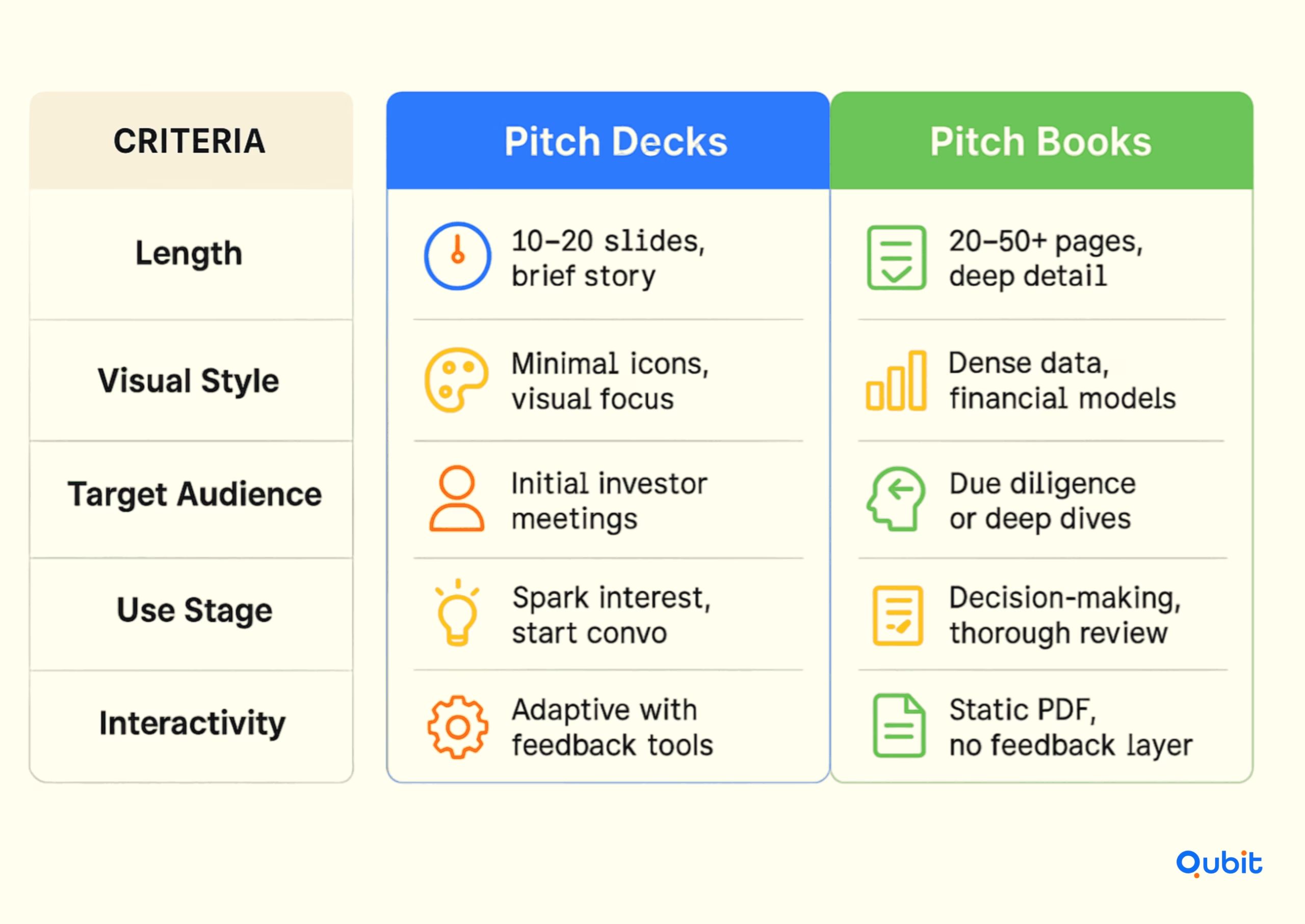When you’re gearing up to woo investors, choosing the right presentation tool can make all the difference. A pitch deck delivers a sharp, visual snapshot of your opportunity, designed to spark curiosity in minutes. While a pitch book dives deeper, laying out comprehensive details on your market positioning, financial projections, and long term strategy.
Mastering both formats ensures you can adapt your story to any audience or stage. In this post we will break down what sets a pitch deck and a pitch book apart and share practical tips so you know exactly when to use each one for maximum impact.
Let’s get started!
What You Need to Know About Pitch Books and Pitch Decks
To effectively communicate what your business is aiming to achieve you need to get an understanding on how pitch book and a pitch deck . While both serve as presentation tools, their structure and purpose differ significantly.
What is Pitch Book?
A Pitch Book is a strategic presentation created by investment banks to promote a business. It includes detailed buyer/seller analysis, risk minimization strategies, and comprehensive financial models. These documents are data-heavy, often featuring intricate charts, graphs, and in-depth financial projections to provide a thorough understanding of the business's potential.
What is Pitch Deck?
A Pitch Deck is designed for startups and focuses on delivering a concise, visually engaging snapshot of the business. It highlights key aspects such as the team, business concept, and growth ambitions. Unlike pitch books, while crafting a pitch deck prioritize strong visuals and simplified messaging to quickly capture investor attention.
The difference lies in their approach: pitch books delve into granular details, making them ideal for formal presentations, while pitch decks emphasize storytelling and visual appeal, making them perfect for initial pitches or casual investor meetings.
Both tools are indispensable, but choosing the right one depends on your audience and the depth of information required.
Pitch Books vs. Pitch Decks: A Side-by-Side Comparison
When crafting an investor presentation, understanding the differences between pitch books and pitch decks is essential. These tools, while both designed to communicate business value, serve distinct purposes and audiences.

Content Depth and Length
Pitch decks are concise, typically spanning 10 to 20 slides, and rely heavily on visual storytelling to convey key points. They are ideal for initial investor meetings, where brevity and clarity are paramount.
In contrast, pitch books are far more comprehensive, often exceeding 20 to 50+ pages, and include detailed financial models, market analyses, and strategic plans. This depth makes pitch books better suited for advanced discussions or due diligence stages.
Visual Emphasis and Audience Targeting
Pitch decks prioritize aesthetics, using charts, infographics, and minimal text to engage audiences quickly. Their design caters to investors who prefer high-level overviews.
Pitch books, however, focus on substance, presenting exhaustive data and insights tailored for stakeholders seeking in-depth evaluations.
Deal-Making Utility
Each format plays a unique role in the deal-making process. Pitch decks act as conversation starters, sparking interest and setting the stage for deeper engagement.
Pitch books, on the other hand, serve as decision-making tools, providing the granular details investors need to assess the viability of a deal.
Interactivity and Flexibility
Modern pitch decks often incorporate AI-driven pitch deck analytics, enabling real-time adjustments based on audience feedback.
This adaptability contrasts with pitch books, which are static documents designed for thorough review rather than interactive presentations.
Complementary Use Cases
Both formats can work in tandem, as illustrated in PitchBook's Enterprise Sales Strategy. A pitch deck might introduce the concept, while a pitch book solidifies the narrative with detailed evidence.
For startups aiming to refine their investor-focused narrative, exploring a business portfolio for startups offers insights into shaping a presentation that effectively reflects your journey.
Work with Experts to Refine Your Pitch Strategy
Crafting a pitch that resonates with investors requires more than just compelling content—it demands precision and expertise. Collaborating with specialists ensures your pitch materials, whether a pitch deck or pitch book, are tailored to meet investor expectations. These professionals bring a nuanced understanding of what investors look for, blending visual storytelling with robust financial data to create a cohesive narrative.
A well-designed pitch deck captures attention with concise visuals, while a pitch book dives deeper into the financial details. Striking the right balance between these formats is crucial for building investor confidence. Experts can help you refine your strategy by aligning your presentation style with the preferences of your target audience, ensuring every slide or page serves a purpose.
Effective investor outreach hinges on presenting data in a way that is both engaging and credible. Specialists can guide you in structuring your materials to highlight key metrics, market opportunities, and growth potential, all while maintaining clarity and professionalism.
Expert Guides on Perfecting Your Pitch
Refining your pitch goes beyond persuasive ideas —it calls for tactical precision. Our expert resources will help you design slides that capture attention and clearly communicate your unique value.
Start with our in-depth walkthrough on crafting a competitive slide for pitch deck contests. You’ll find proven techniques for:
- Highlighting your competitive advantages with clarity
- Mapping the market landscape in a concise, impactful way
- Structuring your slide so it resonates instantly with judges and investors
Read the full guide here: pitch deck competition slide.
Craft a High-Impact Problem Slide
One of the most critical aspects is articulating the problem clearly and aligning it with investor expectations. Missteps in this area often lead to confusion or disengagement, undermining the pitch's effectiveness.
To address this, focus on presenting the pitch deck problem slide in a way that highlights its significance and urgency. This ensures your narrative remains cohesive and impactful. Additionally, refine your storytelling techniques to connect emotionally with your audience while maintaining clarity.
Live Presentations vs. Static Decks: What’s the Difference?
Static pitch decks serve as concise summaries, but live presentations transform information into an engaging narrative. The key distinction lies in the delivery. While pitch decks are ideal for sharing structured data and visuals, live presentations thrive on storytelling and audience interaction.
Dynamic storytelling techniques in live presentations allow speakers to adapt their tone, pace, and emphasis based on audience reactions. This creates a more personalized experience, fostering deeper connections. On the other hand, static decks are limited to pre-designed slides, offering no room for real-time adjustments or emotional engagement.
For businesses aiming to make a lasting impression, live presentations provide the opportunity to highlight passion and authenticity. They bring ideas to life in ways that static decks simply cannot. By prioritizing interaction and adaptability, live presentations can elevate a pitch from informative to unforgettable.
Stand Out with Innovative Pitching Techniques
Investors are drawn to presentations that weave every element into a bold, coherent narrative—one that resonates deeply and leaves a lasting impression.
An innovative pitch thrives on creative risk-taking. By presenting a clear, memorable story, companies can differentiate themselves from competitors and showcase their unique value proposition. This approach not only highlights the business's strengths but also demonstrates its ability to think outside the box, a quality investors often seek.
Rather than relying solely on conventional methods, businesses should focus on aligning their design, data, and delivery with a central theme. When every detail supports the narrative, the pitch becomes more compelling and impactful.
Encourage your team to embrace bold ideas and experiment with storytelling techniques. A well-crafted narrative can transform a standard presentation into a standout opportunity that investors won't forget.
Turn Your Pitch Deck Into an Engaging Story
A story-driven pitch breathes life into static slides, turning data into memorable moments. By weaving your growth strategies and key metrics into a cohesive story, you not only humanize your pitch but also ensure investors retain critical information.
A narrative approach allows you to highlight your company’s journey, challenges, and vision in a way that resonates emotionally. Instead of presenting numbers in isolation, frame them within the context of your goals and achievements. For example, share how a specific milestone reflects your team’s innovation or how your metrics align with market opportunities.
This storytelling method not only engages live audiences but also fosters meaningful investor interactions. It’s about creating a presentation that sticks—one that inspires confidence and drives action.
Conclusion
Securing investor interest requires a thoughtful blend of detailed financial analysis and visually compelling storytelling. Throughout this blog, we’ve emphasized the importance of balancing data-driven insights with concise, narrative-driven visuals to create a pitch deck that resonates. Choosing the right pitch materials is not just about presentation—it’s about building trust and driving successful deal-making.
If you're ready to elevate your investor presentations, we at Qubit Capital can help you build a compelling pitch deck. Check out our Pitch Deck Creation service today.
Key Takeaways
- A strong problem slide grabs investor attention.
- 80% of winning decks start with a clear problem statement.
- Minimal text and impactful visuals improve understanding.
- Avoid jargon and back your points with real examples.
- Leverage templates and tools to speed up slide design.
Frequently asked Questions
What is the difference between a pitch book and a pitch deck?
A pitch book is a detailed document often used by investment banks, containing in-depth financial analyses, charts, and market data to support deal-making decisions. On the other hand, a pitch deck is a concise, slide-based presentation designed to capture investor interest by highlighting key business concepts and opportunities.


 Back
Back



